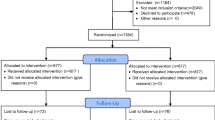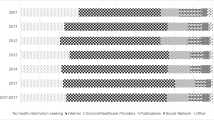Abstract
Although growing research focuses on breast cancer screenings, little is known about breast cancer prevention with risk reduction awareness for ethnic differences among college-age women. This study examined breast cancer prevention knowledge, beliefs, and information sources between non-Hispanic and Hispanic college women. Using a cross-sectional study, women at a university in the Southwest completed a 51-item survey about breast cancer risk factors, beliefs, and media and interpersonal information sources. The study was guided by McGuire’s Input Output Persuasion Model. Of the 546 participants, non-Hispanic college women (n = 277) and Hispanic college women (n = 269) reported similar basic knowledge levels of modifiable breast cancer risk factors for alcohol consumption (52 %), obesity (72 %), childbearing after age 35 (63 %), and menopausal hormone therapy (68 %) using bivariate analyses. Most common information sources were Internet (75 %), magazines (69 %), provider (76 %) and friends (61 %). Least common sources were radio (44 %), newspapers (34 %), and mothers (36 %). Non-Hispanic college women with breast cancer family history were more likely to receive information from providers, friends, and mothers. Hispanic college women with a breast cancer family history were more likely to receive information from their mothers. Breast cancer prevention education for college women is needed to include risk reduction for modifiable health behavior changes as a new focus. Health professionals may target college women with more information sources including the Internet or apps.

Similar content being viewed by others
References
American Cancer Society. (2013). Cancer facts and figures for hispanics/latinos 2012–2014. Atlanta: American Cancer Society.
Colditz, G. A., Wollin, K. Y., & Gehlert, S. (2012). Applying what we know to accelerate cancer prevention. Science Translational Medicine, 4(127), rv4.
Holman, D. M., Grossman, M., Henley, S. J., Peipins, L. A., Tison, L., & White, M. C. (2014). Opportunities for cancer prevention during midlife: Highlights from a meeting of experts. American Journal of Preventive Medicine, 46(30 Suppl 1), S73–S80.
Dart, H., Wolin, K. Y., & Colditz, G. A. (2012). Commentary: Eight ways to prevent cancer: A framework for effective prevention messages for the public. Cancer Causes and Control, 23, 601–608.
Holman, D. M., Rodriquez, J. L., Peipins, L., Watson, M., & White, M. C. (2013). Highlights from a workshop on opportunities for cancer prevention during preadolescence and adolescence. Journal of Adolescent Health, 52(5 Suppl), S8–S14.
Catsburg, C., Kirsh, V. A., Soskolne, C. L., et al. (2014). Associations between anthropometric characteristics, physical activity, and breast cancer risk in a Canadian cohort. Breast Cancer Research and Treatment. doi:10.1007/s10549-014-2973-z.
Arendt, L. M., McCready, J., Keller, P. J., et al. (2013). Obesity promotes breast cancer by CCL2-mediated macrophage recruitment and angiogenesis. Cancer Research, 73(19), 6080–6093.
Eliasson, A. H., Colditz, G. A., Rosner, B., Willett, W. C., & Hankinson, S. E. (2006). Adult weight change and risk of postmenopausal breast cancer. Journal of American Medical Association, 296(2), 193–201.
Trentham-Dietz, A., Sprague, B. L., Hampton, J. M., et al. (2014). Modification of breast cancer risk according to age and menopausal status: A combined analysis of five population-based case-control studies. Breast Cancer Research and Treatment, 145(1), 165–175.
Thomson, C. A., McCullough, M., Wertheim, B. C., et al. (2014). Nutrition and physical activity cancer prevention guidelines, cancer risk, and mortality in the women’s health initiative. Cancer Prevention Research, 7(1), 42–53.
Tucker, P., & Irwin, J. D. (2011). University students’ satisfaction with, interest in improving, and receptivity to attending programs aimed at health and well-being. Health Promotion Practice, 12(3), 388–395.
Burak, L., & Boone, B. (2008). College women and breast cancer: Knowledge, behavior, and beliefs regarding risk reduction. American Journal of Health Education, 39(4), 206–211.
Early, J., Armstrong, S., Burke, S., & Thompson, D. (2011). US female college students’ breast health knowledge, attitudes, and determinants of screening practices: New implications for health education. Journal of American College Health, 59(7), 640–647.
Kratzke, C., Vilchis, H., & Amatya, A. (2013). Breast cancer prevention knowledge, attitudes, and behaviors among college women and mother-daughter communication. Journal of Community Health, 38(3), 560–568.
Marcus, E. N., Drummond, D. K., Dietz, N., & Kenya, S. (2013). Does a bite cause cancer? Misperceptions of breast cancer etiology among low-income urban women in Miami, Florida. Southern Medical Journal, 106(12), 649–654.
Kreuter, M. W., Garibay, L. B., Pfeiffer, D. J., Morgan, J. C., Thomas, M., Wilson, K. M., et al. (2012). Small media and client reminders for colorectal cancer screening: Current use and gap areas in CDC’s colorectal cancer control program. Preventing Chronic Disease, 9, 103110317.
Percheski, C., & Hargittai, E. (2011). Health information seeking in the digital age. Journal of American College Health, 59(5), 379–386.
Munoz, L. R., Etnyre, A., Adams, M., et al. (2010). Awareness of heart disease among female college students. Journal of Women’s Health, 9(12), 2253–2259.
Kratzke, C., Amatya, A., & Vilchis, H. (2014). Difference among college women for breast cancer prevention acquired information seeking, desired apps and text, and daughter initiated information to mothers. Journal of Community Health, 39(2), 291–300.
Fisher, C. (2010). Coping with breast cancer across adulthood: Emotional support communication in the mother-daughter bond. Journal of Applied Communication Research, 38(4), 386–411.
Yun, D., Silk, K., Bowman, N. D., Neuberger, L., & Atkin, C. (2009). Mothers intentions to teach adolescent daughters about breast cancer risk reduction activities: The influence of self efficacy, response efficacy, and personal responsibility. Communication Research Reports, 26(2), 134–145.
Park, K., & Grindel, C. (2007). Korean American mother and daughter communication on women’s health topics. Journal of Cultural Diversity, 14(1), 4–11.
Romo, L. F., Cruz, M. E., & Meilands, T. B. (2011). Mother-daughter communication and college women’s confidence to communicate with family members and doctors about the human papillomavirus and sexual health. Journal of Pediatric Adolescent Gynecology, 24(5), 256–262.
Miller-Ott, A. E., & Durham, W. T. (2011). The role of social support in young women’s communication about the genital HPV vaccine. Women’s Studies in Communication, 34(2), 183–201.
Chou, W. Y., Liu, B., Post, S., & Hesse, B. (2011). Health-related Internet use among cancer survivors: Data from the health information national trends survey, 2003–2008. Journal of Cancer Survival, 5(3), 263–270.
Wallace, L., Lilley, L., Lodrigues, W., et al. (2014). Analysis of internet usage among cancer patients in a county hospital setting: A quality improvement initiative. Journal of Medical Internet Research Protocols, 3(2), e26.
Eheman, C., Berjkowitz, Z., Lee, J. W., et al. (2009). Information seeking styles among cancer patients before and after treatment by demographics and use of information sources. Journal of Health Communication, 14(5), 487–502.
Mosavel, M., & Genderson, M. W. (2013). From adolescent daughter to mother: Exploring message design strategies for breast and cervical cancer prevention and screening. Journal of Cancer Education, 28(3), 558–564.
Burns, E. R. (2014). Cancer prevention and control: Where are the kids? Journal of Cancer Education, 29, 209–210.
McGuire, W. (1989). Theoretical foundations of campaigns. Public communication campaigns (2nd ed., pp. 43–65). Newbury Park: Sage.
National Cancer Institute. Health Information National Trends Survey. Retrieved May 20, 2014 from http://hints.cancer.gov/instrument.aspx.
Silk, K. J., Perrault, E. K., Neuberger, L., et al. (2014). Translating and testing breast cancer risk reduction messages for mothers of adolescent girls. Journal of Health Communication, 19(2), 226–243.
Acknowledgments
This work was supported by the New Mexico State University Faculty Rising Star Grant.
Author information
Authors and Affiliations
Corresponding author
Rights and permissions
About this article
Cite this article
Kratzke, C., Amatya, A. & Vilchis, H. Breast Cancer Prevention Knowledge, Beliefs, and Information Sources Between Non-Hispanic and Hispanic College Women for Risk Reduction Focus. J Community Health 40, 124–130 (2015). https://doi.org/10.1007/s10900-014-9908-9
Published:
Issue Date:
DOI: https://doi.org/10.1007/s10900-014-9908-9




